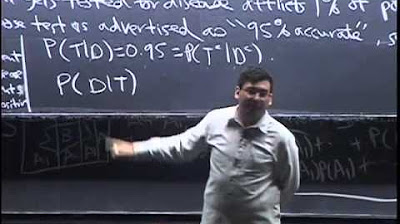Statistics in the Courts: Crash Course Statistics #40
TLDRThis video examines three court cases where statistics were misused, leading to unjust outcomes. It starts with the Dreyfus affair in France, where dubious handwriting analysis falsely convicted Alfred Dreyfus. Next it covers the Sally Clark case, where a flawed statistical calculation led to her conviction for murdering her children. Finally, it discusses the case of Jonathan Dorfman, who was expelled for cheating based on a misleading one-in-a-billion statistic. The video highlights how misunderstanding probability and assuming independence can distort legal proceedings.
Takeaways
- 😀 Statistics were misused in the trials of Alfred Dreyfus, Sally Clark, and Jonathan Dorfman, leading to unfair convictions.
- 😟 In the Dreyfus case, Bertillon used flawed statistical analysis of handwriting to argue Dreyfus forged the bordereau.
- 😠 Dr. Meadow made a faulty statistical assumption in Sally Clark's trial, greatly overestimating the probability of two SIDS deaths.
- 😡 Sally Clark's conviction was overturned when new medical records showed her child could have had an infection.
- 😢 In statistics, it's important to consider multiple hypotheses, not just one or two.
- 😭 The prosecutor's fallacy wrongly claims that just because one hypothesis is unlikely, another must be more likely.
- 😨 In Jonathan Dorfman's case, the probability of matching wrong answers was assumed to be independent when it wasn't.
- 😓 Matching wrong answers between students are often dependent based on shared misconceptions.
- 😞 Poor probability calculations can improperly influence legal cases.
- 😀 Understanding basic statistical rules helps avoid coming to wrong conclusions.
Q & A
What was the key evidence used to convict Alfred Dreyfus of treason?
-An unsigned letter called the bordereau that offered French military secrets for sale. The courts decided that Dreyfus had written this letter.
What mistake did the handwriting expert Alphonse Bertillon make in analyzing the bordereau letter?
-Bertillon overlapped his handwriting sample key with the bordereau letter twice, causing him to double count the number of overlapping letters. This made it seem like the bordereau matched Dreyfus's handwriting much more than it actually did.
How did Dr. Roy Meadow miscalculate the probability of two SIDS deaths happening in Sally Clark's family?
-He incorrectly assumed the two deaths were independent events. In reality, SIDS deaths within the same family may be dependent due to shared genetics or environment, making the probability much higher than his claimed 1 in 73 million.
What is the Prosecutor's Fallacy that affected Sally Clark's trial?
-The assumption that because SIDS was an extremely unlikely cause of death, murder must have been more likely. But there could have been other natural causes unrelated to SIDS.
What evidence was used to accuse Jonathan Dorfman of cheating on an exam?
-His test answers matched another student's answers very closely - they had 8 out of 10 incorrect answers and all 16 correct answers in common.
Why was the 1 in a billion probability of Dorfman's matching answers happening by chance likely inaccurate?
-It incorrectly assumed answer choices were independent between students. But students tend to make similar mistakes based on shared misconceptions from the same course, making matching incorrect answers more likely.
How many students were found to have a similarly high degree of answer matching with Dorfman?
-44 out of 618 students had between 23-25 answers matching Dorfman's.
How did poor identification of probabilities affect the trials of Dreyfus, Clark, and Dorfman?
-In all three cases, improbable probabilities were presented without accounting for dependencies or additional options. This gave a false impression of extreme unlikelihood that influenced the outcomes.
How could analysis of the bordereau letter have been improved?
-By only overlapping the handwriting sample key once instead of twice, giving a more accurate probability of letter matches happening by chance.
What additional information was needed in Dorfman's case?
-The identity of Student X, to determine if they were cooperating or sitting together, which could explain the matching answers.
Outlines
😞 The Conviction and Trial of Alfred Dreyfus for Treason
Paragraph 1 discusses the political scandal and trial of Alfred Dreyfus, a Jewish French army officer convicted of treason in 1894 based on questionable handwriting analysis of the 'bordereau' letter by Alphonse Bertillon. His flawed statistical analysis comparing the letter to writing samples was rebutted by French mathematicians, helping free Dreyfus.
😟 Dr. Meadow's Faulty Probabilistic Testimony in Sally Clark's Trial
Paragraph 2 covers the wrongful conviction of Sally Clark for murdering her two infant sons in 1998. Dr. Meadow provided flawed statistical testimony on the probability of two SIDS deaths occurring in one family, failing to consider dependence between events. His errors contributed to her conviction being overturned.
😕 Misleading Statistical Evidence in Jonathan Dorfman's Cheating Case
Paragraph 3 discusses student Jonathan Dorfman's 2011 academic misconduct case at UC San Diego involving alleged cheating on a chemistry exam. Misleading statistical evidence about matching wrong answers was presented but later disputed. More information was needed to update the probabilities.
Mindmap
Keywords
💡statistics
💡probability
💡error
💡independence
💡fallacy
💡hypothesis
💡probability
💡assumption
💡context
💡bayesian
Highlights
First significant research finding
Introduction of new theoretical model
Discussion of potential real-world applications
Transcripts
Browse More Related Video

Peter Donnelly: How stats fool juries

He Said, She Said | Testifying at a Sexual Assault Trial

Lecture 5: Conditioning Continued, Law of Total Probability | Statistics 110

AP Daily: AP Statistics (1.1)

Inside the trial of Louise Woodward: Baby killer or victim of flawed justice? | 60 Minutes Australia

Evidence Law: The Rule of Relevance and Admissibility of Character Evidence
5.0 / 5 (0 votes)
Thanks for rating: